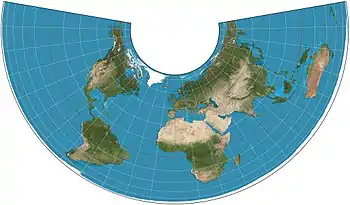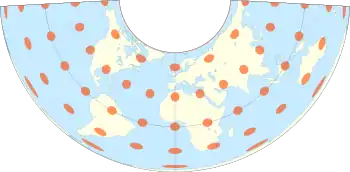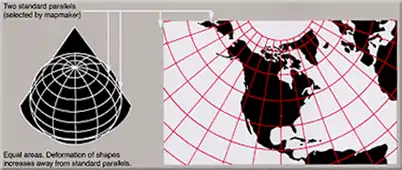Albers projection
The Albers equal-area conic projection, or Albers projection (named after Heinrich C. Albers), is a conic, equal area map projection that uses two standard parallels. Although scale and shape are not preserved, distortion is minimal between the standard parallels.



The Albers projection is used by the United States Geological Survey and the United States Census Bureau.[1] Most of the maps in the National Atlas of the United States use the Albers projection.[2] It is also one of the standard projections used by the government of British Columbia,[3] and the sole governmental projection for the Yukon.[4]
Formulas
For Sphere
Snyder[5] describes generating formulae for the projection, as well as the projection's characteristics. Coordinates from a spherical datum can be transformed into Albers equal-area conic projection coordinates with the following formulas, where is the radius, is the longitude, the reference longitude, the latitude, the reference latitude and and the standard parallels:
where
See also
References
- "Projection Reference". Bill Rankin. Archived from the original on 25 April 2009. Retrieved 2009-03-31.
- Snyder, John P. (1987). Map Projections – A Working Manual. U.S. Geological Survey Professional Paper 1395. Washington, D.C.: United States Government Printing Office. p. 2. Archived from the original on 2008-05-16. Retrieved 2017-08-28.
- "Support & Info: Common Questions". Geomatics Yukon. Government of Yukon. Retrieved 15 October 2014.
- Snyder, John P. (1987). "Chapter 14: ALBERS EQUAL-AREA CONIC PROJECTION". Map Projections – A Working Manual. U.S. Geological Survey Professional Paper 1395. Washington, D.C.: United States Government Printing Office. p. 100. Archived from the original on 2008-05-16. Retrieved 2017-08-28.
External links
| Wikimedia Commons has media related to Albers projection. |
- Mathworld's page on the Albers projection
- Table of examples and properties of all common projections, from radicalcartography.net
- An interactive Java Applet to study the metric deformations of the Albers Projection.